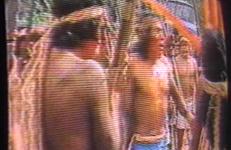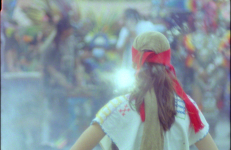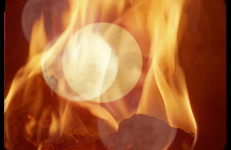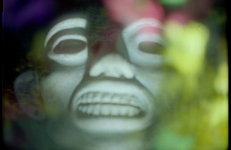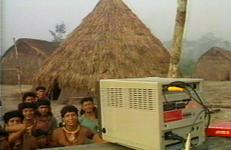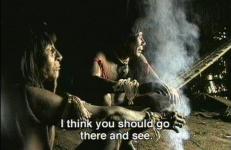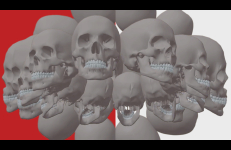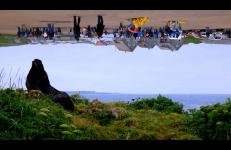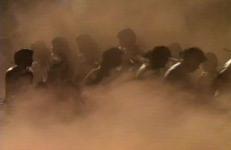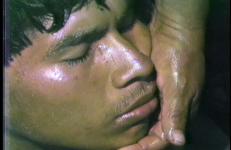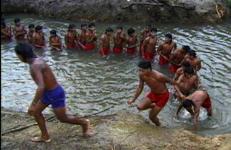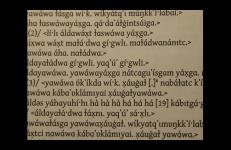Beginning with the arrival by canoe of a TV and VCR in their village, The Spirit of TV documents the Waiãpi people’s first encounter with TV images of themselves and others. They view a tape from their chief’s first trip to Brasilia to speak to the government, news broadcasts, and videos of other Brazilian native peoples, and record a session directed by Chief Waiwai for villages in his territory.
Indigenous
Moments of resistance are collapsed and woven together; from documentation of the Indigenous led occupation of Alcatraz, to the reclamation of Cahokia and the repatriation of the ancestors, to one’s reflections on their body as they exist in the world today, these are gestures that meditate on the carceral inception and nature of the reservation system, and where sovereignty and belligerence intersect and diverge.
Sound by Courtney Asztalos
Music by Room Thirteen
Commissioned by the San Jose Museum of Art and the Institute of Arts and Sciences at UC Santa Cruz.
Divino explains how he got introduced to video. “Filming is my profession; that’s what I was born to do... not for the work with the axe. I wasn’t born to plant. I already said this to my wife.” Today, Divino dominates the language of video and its filming and editing techniques. He also talks about working in partnership with his community.
Directed by Divino Tserewahu; edited by Tutu Nunes.
In Portuguese with English subtitles.
Contemplating mixed race identity in Canada, Cuthand presents us with images of blood ties and land ties for indigenous people, and questions the use of the words "white passing" and "light skinned." As a light skinned indigenous, Cuthand reiterates that racism and discrimination still happen for him, just in different ways. Community belonging is contrasted with the difference experiences he has from his darker skinned family. Ultimately, a video with more questions than answers, it situates the artist's body in historical trauma and ongoing colonial survival.
These are the dancing bodies in an agitated rapture: prelude to trance, invocation of the gods, consecration of intermittence. Here our point of view sparkles under the spell and trance of things gathered, fallen, yielding, pluvial, Mesoamerican wind, goddess breath, breeze of sticks. percussive woods.
Tlecáxitl is the sacred furnace where the new fire begins. This is the place where the sun, the moon and fire coincide in their cosmic dance to unleash vital irradiation. Part of Tonalli.
This video retells and disorders an important of a pre-Columbian Native American city directly across the Mississippi River from modern St. Louis, Missouri: a location that is visited, preserved, and endlessly repeated via prescribed routes and prerecorded narratives. Rather than strive for originality, my intention is to work with found audio so as to displace these repetitions.
Producer/ Director: Sabine Gruffat
"A personal guided tour of the largest prehistoric city North of Mexico.” - Anonymous
“Drawing on the ancient Nahuatl concept of the animating soul or life force, Tonalli engages the ritualistic powers of the cinema, summoning fire, flowers, and many moons into a frenetic and mesmerizing in-camera collage. Here, amid thickly swirling images and textured abstractions, the gods of creation and fertility manifest, dissolving into iridescent colors and dense, corporeal rhythms.” NYFF59
Video is introduced to the Enauênê Nauê Indians, a group still isolated in the North of Mato Grosso. An outgoing group, they respond with a surprising high-spirited performance that includes a good measure of clowning around and a re-enactment of an attack they suffered at the hands of their neighbors, the Cinta-Larga, not long ago. After growing accustomed to watching movies on video, they decide to produce their own.
Directed and photographed by Vincent Carelli.
In Enauenê-Nauê with English subtitles.
Video is introduced to the Enauênê Nauê Indians, a group still isolated in the North of Mato Grosso. An outgoing group, they respond with a surprising high-spirited performance that includes a good measure of clowning around and a re-enactment of an attack they suffered at the hands of their neighbors, the Cinta-Larga, not long ago. After growing accustomed to watching movies on video, they decide to produce their own.
Directed and photographed by Vincent Carelli.
In Enauenê-Nauê with English subtitles.
An overview of the Video in the Villages Project, this documentary shows how four different Amazonian native groups (Nambiquara, Gavião, Tikina, and Kaiapó) have embraced video and incorporated it in the service of their projects for political and ethnic affirmation.
Directed and photographed by Vincent Carelli.
An overview of the Video in the Villages Project, this documentary shows how four different Amazonian native groups (Nambiquara, Gavião, Tikina, and Kaiapó) have embraced video and incorporated it in the service of their projects for political and ethnic affirmation.
Directed and photographed by Vincent Carelli.
Video in the Villages presents its recent progress, its indigenous workshops for training and production. Founded in 1987, the project began with the introduction of video to indigenous communities that produced documentaries for their own purposes. In 1995, the opening of a space on educational TV in Cuiabá led to “Indigenous Program.” Since 1997, Video in the Villages has invested in the formation of the first generation of indigenous documentary filmmakers through national and regional workshops.
Directed by Mari Corrêa and Vincent Carelli; edited by Mari Corrêa.
Video in the Villages presents its recent progress, its indigenous workshops for training and production. Founded in 1987, the project began with the introduction of video to indigenous communities that produced documentaries for their own purposes. In 1995, the opening of a space on educational TV in Cuiabá led to “Indigenous Program.” Since 1997, Video in the Villages has invested in the formation of the first generation of indigenous documentary filmmakers through national and regional workshops.
Directed by Mari Corrêa and Vincent Carelli; edited by Mari Corrêa.
An urgent reflection on indigenous sovereignty, the undead violence of museum archives, and postmortem justice through the case of the "Kennewick Man," a prehistoric Paleo-American man whose remains were found in Kennewick, Washington, in 1996.
Directors: Adam Khalil, Zack Khalil, Jackson Polys
Director Of Photography: Samuli Haavisto
Producers: Mariana Silva, Pedro Neves Marques
Co Editors: Zack Khalil, Adam Khalil
Commissioned By: inhabitants, Contour Biennale 8, Natasha Ginawala
Executive Producer: Steve Holmgren
An urgent reflection on indigenous sovereignty, the undead violence of museum archives, and postmortem justice through the case of the "Kennewick Man," a prehistoric Paleo-American man whose remains were found in Kennewick, Washington, in 1996.
Directors: Adam Khalil, Zack Khalil, Jackson Polys
Director Of Photography: Samuli Haavisto
Producers: Mariana Silva, Pedro Neves Marques
Co Editors: Zack Khalil, Adam Khalil
Commissioned By: inhabitants, Contour Biennale 8, Natasha Ginawala
Executive Producer: Steve Holmgren
An urgent reflection on indigenous sovereignty, the undead violence of museum archives, and postmortem justice through the case of the "Kennewick Man," a prehistoric Paleo-American man whose remains were found in Kennewick, Washington, in 1996.
Directors: Adam Khalil, Zack Khalil, Jackson Polys
Director Of Photography: Samuli Haavisto
Producers: Mariana Silva, Pedro Neves Marques
Co Editors: Zack Khalil, Adam Khalil
Commissioned By: inhabitants, Contour Biennale 8, Natasha Ginawala
Executive Producer: Steve Holmgren
An Unangam Tunuu elder describes cliffs and summits, drifting birds, and deserted shores. A group of students and teachers play and invent games revitalizing their language. A visitor wanders in a quixotic chronicling of earthly and supernal terrain. These visions offer glimpses of an island in the center of the Bering Sea.
Within the long cycle of initiation ceremonies of the Xavante People, the Wai’a celebration introduces young men to spiritual life and puts them in contact with supernatural forces. Filmmaker Divino Tserewahu speaks with his father (one of the leaders of this ritual) about what can be disclosed of this secret celebration of men, where the initiated go through many trials and tribulations.
Directed by Divino Tserewahú.
In Xavante with English subtitles.
Among the Xavante of Mato Grosso, the Wai’a is an important stage in a male initiation ritual that happens once every 15 years. Wai’a: The Secret of Men documents the ceremonies that prepare young men for contact with supernatural forces. The young people of the village directed the filming and assisted with the editing to make a record for the next generation.
Directed by Virginia Valadão.
In Xavante with English subtitles.
Among the Xavante of Mato Grosso, the Wai’a is an important stage in a male initiation ritual that happens once every 15 years. Wai’a: The Secret of Men documents the ceremonies that prepare young men for contact with supernatural forces. The young people of the village directed the filming and assisted with the editing to make a record for the next generation.
Directed by Virginia Valadão.
In Xavante with English subtitles.
A documentary about the initiation ritual for young Xavante Indians, created during a training workshop for the Video in the Villages project. Invited by Divino from the Sangradouro village, one Suyú and four Xavantes Indians film together for the first time. While filming the ritual, various members of the village explain the significance of the complex ceremony’s elements.
Directed and photographed by Bartolomeu Patira, Caimi Waiassé, Divino Tserewahú, Jorge Protodi, Whinti Suyá; edited by Tutu Nunes.
In Xavante with English subtitles.
Wawa peeks at the anxieties and difficulties of communication through the interactions between speakers of an endangered Indigenous language, each from differing cultural backgrounds and generations. By transforming the chronology of the language, it weaves the past and present into a single entity and confronts various modes of conversation, translation, identity, and history.
This tape documents a cultural exchange between the Parakatêjê (Gavião) of Pará and their “relatives,” the Krahô of Tocantins. Kokrenum, the charismatic chief of the Parakatêjê, organizes a visit to the Krahô, who speak the same language and maintain their traditions. The 50 young Parakatêjê he brings along participate in a ceremony consisting of singing, body painting, and preparations for the long, strenuous relay race through the savannah. The following year, the Parakatêjê return the invitation and the Krahô travel to Kokrenum’s village.
This tape documents a cultural exchange between the Parakatêjê (Gavião) of Pará and their “relatives,” the Krahô of Tocantins. Kokrenum, the charismatic chief of the Parakatêjê, organizes a visit to the Krahô, who speak the same language and maintain their traditions. The 50 young Parakatêjê he brings along participate in a ceremony consisting of singing, body painting, and preparations for the long, strenuous relay race through the savannah. The following year, the Parakatêjê return the invitation and the Krahô travel to Kokrenum’s village.




